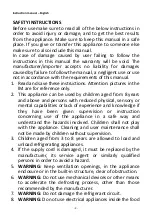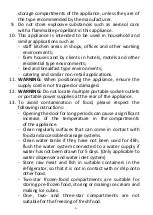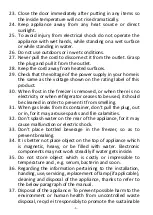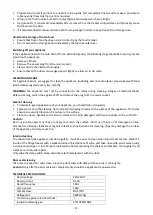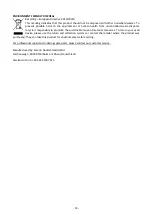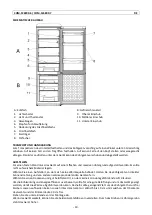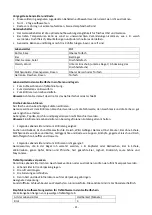
- 8 -
Make sure the adjustable legs are clung to the floor, and set the appliance slope backward slightly for keeping
the doors closed tightly.
FIRST USE
Before the use of the refrigerator, remove all the packages, including bottom cushion and foam pads and rubber
belts in the refrigerator.
Adjust the feet and clear the outside and inside of the refrigerator with warm cloth.
Do not start the refrigerator immediately after vertical placement. Only start it after 2-6 hours standing to ensure
its proper operation.
To prevent damage to the power cord and any consequence incidents, the power cord should not be covered
by the refrigerator or other objects. Before switching on the refrigerator, please check the voltage range of the
refrigerator carefully if the same as that of the power supply.
When the refrigerator is first installed, allow it to stabilize at normal operating temperatures for 2-3 hours prior
to filling it with fresh or frozen foods.
If operation is interrupted, wait for 5 minutes before restarting.
TEMPERATURE CONTROL
The temperature in the refrigerator compartment and freezer compartment is controlled by the thermostat
knob installed on the right side of the refrigerator compartment.
However, the numbers shown on the knob does not directly represent the temperature but the temperature
grades from
“0”
to
“7”. “0” stands for off. “7” stands for the coldest temperature level.
Under this level, the
temperature in every compartment will be at the lowest degree and in the fridge compartment the temperature
will be probably below 0 °C, so please choose carefully. The larger the number is, the lower the interior
temperature will be. Turn the knob to level 3-5 for a normal use.
STORAGE OF FOOD
Your appliance has the accessories as the “Structure illustration” showed in general, with this part instruction
you can have the right way to storage your food.
Storing food in the refrigerator compartment
The fridge compartment helps to extend the storage times of fresh perishable foods.
Fresh food care for best results:
•
Store foods that are very fresh and of good quality.
•
Ensure that food is well wrapped or covered before it is stored. This will prevent food from dehydrating,
deteriorating in color or losing taste and will help maintain freshness. It will also prevent odor transfer.
Vegetables and fruit
don’t need to be wrappe
d if they are stored in the vegetable container of the fridge
compartment.
•
Make sure that strong smelling foods are wrapped or covered and stored away from foods such as butter,
milk and cream which can be tainted by strong odors.
•
Cool hot foods down before placing them in the fridge compartment.
Dairy foods and eggs
•
Most pre-packed dairy foods have a recommended
‘
use by /best before/best by/
’
date stamped on them.
Store them in the fridge compartment and use within the recommended time.
•
Butter can become tainted by strong smelling foods so it is best stored in a sealed container.
•
Eggs should be stored in the fridge compartment.
Red meat
•
Place fresh red meat on a plate and loosely cover with waxed paper, plastic wrap or foil.
•
Store cooked and raw meat on separate plates. This will prevent any juice lost from the raw meat from
contaminating the cooked product.
Precooked foods and leftovers
•
These should be stored in suitable covered containers so that the food will not dry out.
•
Keep for only 1-2 days.
•
Reheat leftovers only once and until steaming hot.
Summary of Contents for COM-126800.6
Page 1: ...COM 126800 6 COM 126800 7...



